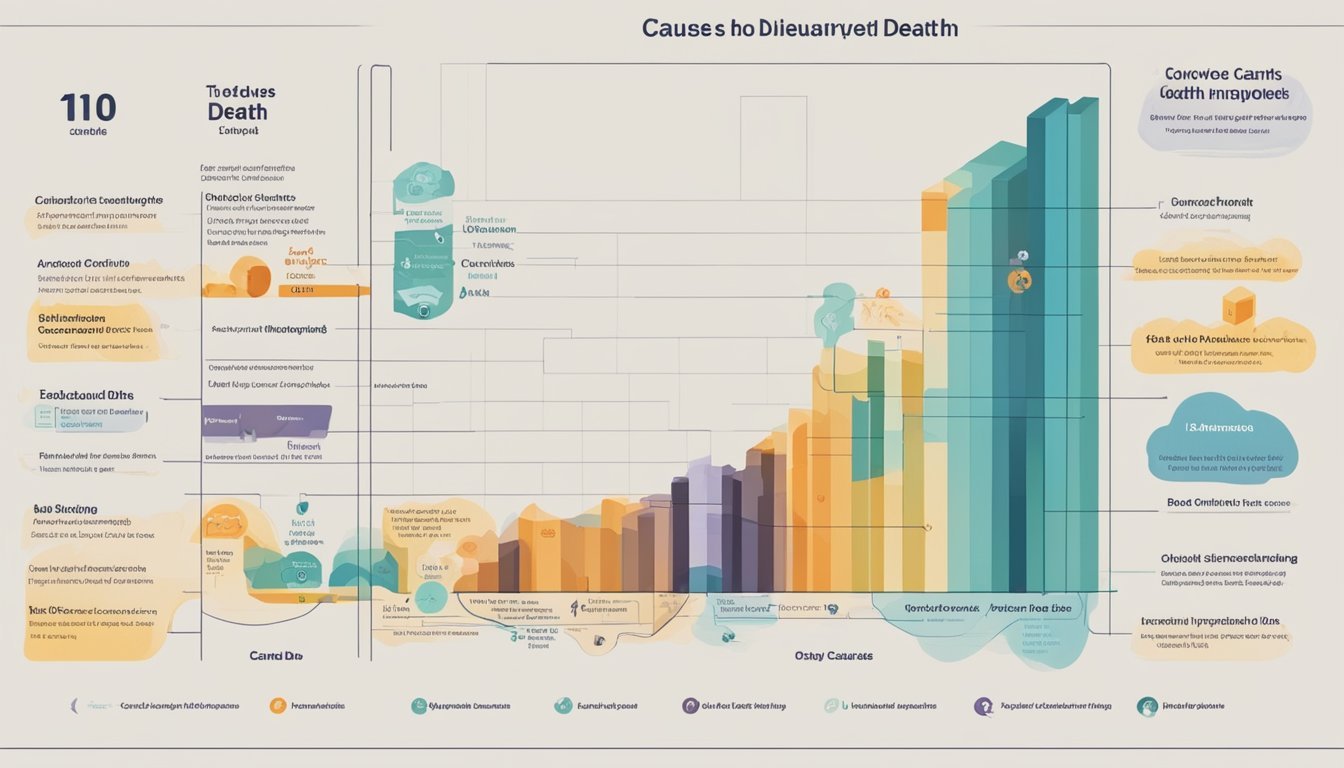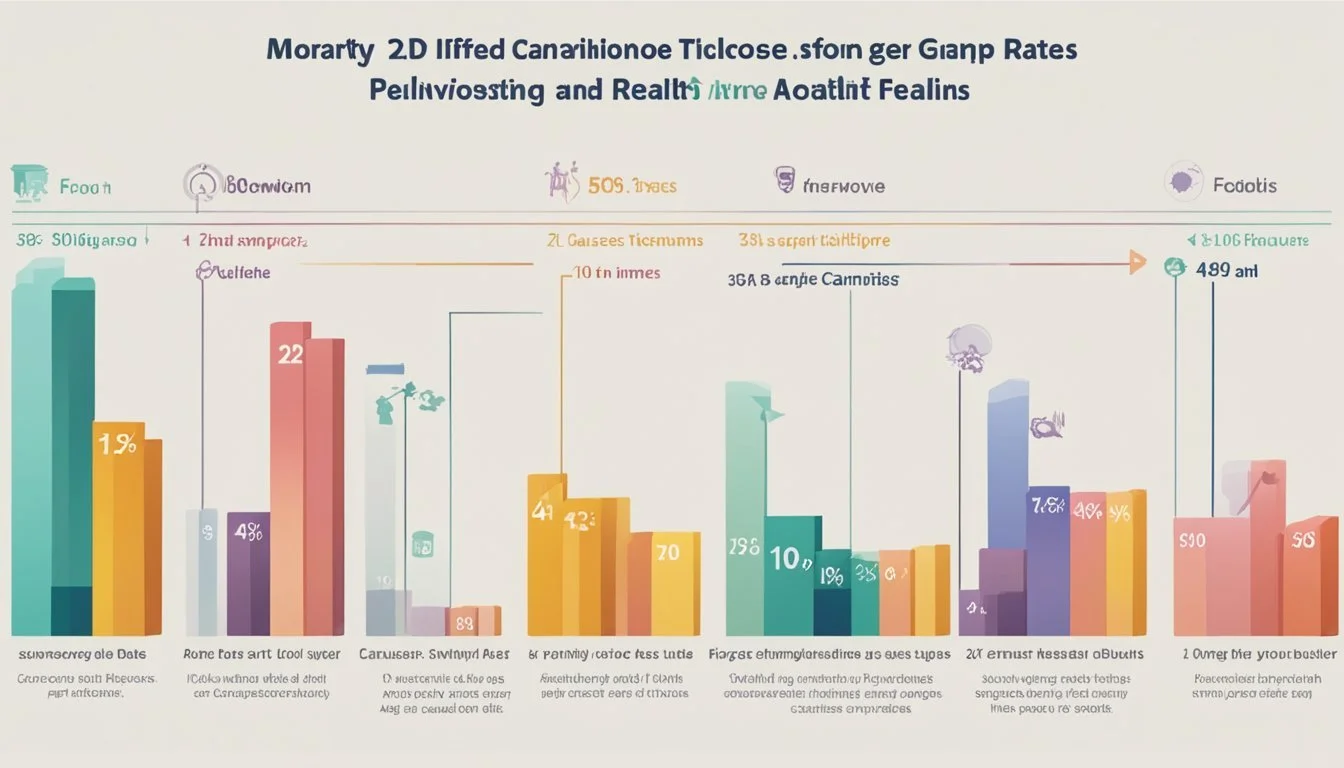Top 10 Leading Causes of Death Through the Ages
A Carnivore Diet Perspective Explained
The leading causes of death have shifted dramatically over the centuries, influenced by changes in medicine, lifestyle, and diet. From infectious diseases like the plague and tuberculosis to modern-day killers such as heart disease and cancer, these shifts tell a compelling story about human health and behavior. Cardiovascular disease has emerged as the leading cause of death in the United States, with diet playing a crucial role in its development.
This exploration will examine the top 10 leading causes of death through the ages from a unique perspective, considering the impact of a carnivore diet. While plant-based diets are often lauded for their health benefits, it is essential to understand how a diet predominantly composed of animal products fits into this context. In recent years, there has been a growing interest in the potential health benefits and risks associated with carnivorous diets, especially in relation to cardiovascular health and mortality rates.
Understanding how dietary patterns, including the carnivore diet, have intersected with the leading causes of death can provide valuable insights. This perspective not only sheds light on historical health trends but also helps frame current debates about optimal nutrition for longevity and disease prevention.
Historical Perspective on Leading Causes of Death
Throughout history, the factors contributing to mortality have evolved significantly. This evolution reflects the shifts in societal structure, advancements in medical knowledge, changes in nutrition, and the advent of industrialization.
Prehistoric Times to Medieval Ages
In prehistoric times, life expectancy was low primarily due to harsh living conditions and limited medical knowledge. Infectious diseases such as tuberculosis, pneumonia, and various zoonotic infections were rampant. Malnutrition and injuries from hunting or conflicts were also significant contributors to mortality.
As societies progressed into the medieval ages, overcrowding in cities and lack of sanitation led to widespread outbreaks of plague, smallpox, and other communicable diseases. Malnutrition continued to weaken populations, making them more susceptible to infections.
Industrial Revolution to Early 20th Century
The Industrial Revolution brought significant changes. Urbanization intensified, leading to pollution and poor living conditions, which exacerbated the spread of infectious diseases like influenza and tuberculosis. Child labor and unsafe working environments also increased injury-related deaths.
In the early 20th century, scientific advancements began to combat infectious diseases. Vaccines and antibiotics started to reduce mortality rates from diseases such as tuberculosis and pneumonia. However, new challenges like heart disease and cancer started to emerge, reflecting lifestyle changes and aging populations.
Late 20th Century to Present
In the late 20th century and onwards, heart disease and cancer have become leading causes of death, particularly in developed countries like the United States. Improved disease prevention and nutrition have reduced deaths from infectious diseases, but stroke and chronic conditions now play a significant role.
Modern factors include dietary habits and sedentary lifestyles, contributing to obesity, diabetes, and cardiovascular issues. Public health decisions rooted in data from systems like the National Vital Statistics System help tackle these ongoing health challenges by focusing on prevention and effective interventions.
Role of Nutrition in Mortality
Proper nutrition plays a crucial role in influencing mortality rates through its impact on chronic diseases, weight management, and overall health. The effects of different dietary patterns, including the carnivore diet, and a lack of essential nutrients can be substantial.
Impact of Carnivore Diet on Health
The carnivore diet, consisting exclusively of animal products such as meat, eggs, and dairy, has drawn interest for its potential health benefits. Advocates claim it can aid weight loss, improve mental clarity, and manage diabetes. High protein and fat intake can lead to satiety and reduced caloric consumption. Conversely, critics highlight risks like increased cholesterol and potential deficiencies in essential vitamins and fiber, potentially elevating risks for osteoporosis and heart conditions.
Vegetables, Fruits, and Grains in Historical Diets
Historically, diets rich in vegetables, fruits, and grains have been linked to lower all-cause mortality. These food groups provide essential vitamins, minerals, and fiber, which support immune function and cardiovascular health. Reducing intake of processed foods and sugar, while increasing consumption of whole foods, has shown a marked decrease in obesity, diabetes, and cardiovascular diseases. The lower fat content and higher antioxidants in these diets can combat oxidative stress and inflammation, which play roles in chronic disease development.
Nutritional Deficiencies and Excesses
Deficiencies in key nutrients like vitamins A, D, and calcium can lead to conditions such as osteoporosis and weakened immune responses. Vitamin deficiencies impair metabolic processes and increase vulnerability to diseases. On the other hand, excess consumption of certain nutrients poses risks too. Diets high in saturated fats and cholesterol can contribute to heart disease, while excessive sugar intake is a primary factor in rising diabetes and obesity rates. Balanced nutrition, ensuring adequate but not excessive nutrient intake, is critical in managing health and reducing mortality risks.
Make your life easier by ordering vitamin A, vitamin D, and calcium online; it's just a few clicks away!
Non-Communicable Diseases (NCDs) and Mortality
Non-communicable diseases (NCDs) are significant contributors to global mortality, particularly cardiovascular diseases, various types of cancer, and diabetes. These chronic conditions have strong associations with dietary choices, emphasizing the importance of proper nutrition.
Cardiovascular Diseases and Diet
Cardiovascular diseases, including ischaemic heart disease and stroke, are leading causes of death worldwide. High blood pressure, a prominent risk factor for these conditions, can be influenced by dietary choices. Diets high in saturated fats, trans fats, and sodium are known to elevate blood pressure and cholesterol levels, increasing the risk of heart disease.
A diet focused on low carbohydrate intake, such as the ketogenic diet, has been studied for its potential benefits in reducing cardiovascular risk factors. By limiting carb intake and increasing healthy fats, individuals may experience reduced insulin resistance and lower inflammation, potentially decreasing the risk of cardiovascular events.
Cancer Types Influenced by Diet
Several types of cancer, including lung, colon, and stomach cancers, show correlations with dietary habits. Smoking remains the primary risk factor for lung cancer, but diet can influence other cancer types. For instance, a diet high in red and processed meats has been linked to an increased risk of colon cancer.
Conversely, diets rich in fruits, vegetables, and fiber can potentially reduce the likelihood of developing certain cancers. Additionally, some studies suggest that low-carb, high-fat diets, like keto, may help in reducing the growth of some cancer cells by limiting their glucose supply.
Diabetes and Dietary Choices
Type 2 diabetes and dietary choices are closely linked. Insulin resistance, a hallmark of type 2 diabetes, can be exacerbated by poor diet. High intake of refined sugars and carbohydrates contributes to increased blood glucose levels and insulin resistance.
Adopting a low-carb diet, such as keto, can significantly affect blood sugar levels and insulin sensitivity. By reducing carbohydrate intake, individuals can better manage their blood glucose levels, potentially reversing insulin resistance and managing type 2 diabetes more effectively. This dietary approach emphasizes the consumption of healthy fats and proteins, which support stable blood sugar levels.
Communicable Diseases and Death Rates
Communicable diseases have long been a significant cause of mortality worldwide. Understanding their impact requires examining specific viral, bacterial, and parasitic conditions and the role of vaccination in prevention.
Viral Diseases and Infections
Viral infections such as HIV/AIDS, COVID-19, influenza, and hepatitis have drastically shaped global health trends. HIV/AIDS remains a leading cause of death, particularly in low-income regions. Despite advancements in antiretroviral treatments, it accounts for millions of deaths annually.
COVID-19 emerged as a global pandemic, highlighting vulnerabilities within public health systems. The virus led to substantial mortality and morbidity, with millions affected worldwide. Influenza remains an endemic threat, causing seasonal epidemics. Hepatitis B and C are major health concerns, contributing to liver disease and cancer.
Bacterial and Parasitic Conditions
Bacterial infections such as tuberculosis and diseases caused by parasitic organisms like malaria are major contributors to communicable disease mortality. Tuberculosis (TB), caused by Mycobacterium tuberculosis, primarily affects the lungs and remains a top killer globally, particularly in densely populated urban areas.
Malaria, transmitted by Anopheles mosquitoes, is prevalent in tropical and subtropical regions. Despite preventive measures and treatment advancements, it continues to cause significant death rates, especially among children. Other bacterial diseases causing high mortality include pneumonia, which affects vulnerable populations such as the elderly and young children.
Vaccination and Disease Prevention
Vaccination has been a cornerstone of reducing death rates from communicable diseases. Widespread immunization programs have successfully diminished diseases like smallpox and polio. Vaccines for measles, mumps, rubella, HPV, and influenza have drastically reduced incidences and complications.
Public health initiatives play a critical role in curbing disease spread. This includes mass vaccination campaigns and educational efforts to promote hygiene and preventative measures. Herd immunity, achieved through vaccination, protects unvaccinated individuals by reducing disease transmission. Continued investment in vaccine research for diseases like HIV and malaria holds promise for future mortality reduction.
Communicable diseases demand ongoing vigilance and comprehensive strategies encompassing vaccination, public health policies, and medical research to mitigate their impact on mortality rates.
Lifestyle, Environment, and Mortality
Lifestyle choices and environmental factors significantly impact mortality rates. Key factors include smoking, alcohol use, physical activity levels, sedentary behavior, and environmental conditions like air and water quality.
Smoking and Alcohol Use
Smoking is a leading cause of respiratory diseases, including chronic lower respiratory diseases and cancers. It contributes to millions of deaths each year. Alzheimer’s disease links to smoking, though less directly.
Alcohol-related deaths span various health issues, from liver disease to accidents. Excessive alcohol use increases the risk of cardiovascular diseases, cancers, and digestive issues. These behaviors profoundly affect public health and mortality.
Physical Activity and Sedentary Behavior
Regular physical activity lowers the risk of chronic diseases such as heart disease, stroke, and diabetes. Exercise improves overall health and longevity.
Conversely, a sedentary lifestyle contributes to numerous health issues, including obesity, heart disease, and metabolic syndrome. Prolonged inactivity can also lead to mental health problems. Encouraging active lifestyles is vital for reducing mortality rates related to these conditions.
Environmental Factors and Public Health
Air pollution and poor water quality are major environmental health concerns. Polluted air leads to respiratory diseases, heart conditions, and premature death.
Contaminated water can cause various health issues, including digestive problems and infectious diseases. Public health measures aimed at improving environmental conditions can significantly reduce health risks and improve life expectancy. Effective policies in this area are crucial for public health.
Accidents, Injuries, and Unexpected Fatalities
Accidents and injuries remain a leading cause of death across various demographics, stemming from traffic incidents, industrial accidents, and domestic mishaps. Effective public policies can mitigate these risks through better safety regulations and resources.
Traffic and Industrial Incidents
Traffic incidents are a significant cause of accidental deaths globally. Speeding, distracted driving, and impaired driving contribute to high fatality rates. In 2022, traffic accidents accounted for a high number of deaths due to human error and lack of safety measures.
Industrial accidents, involving machinery and hazardous materials, also pose significant risks. Enhanced workplace safety protocols, regular inspections, and proper training can reduce these fatalities. Stricter regulatory compliance and technological advancements in safety equipment are crucial.
Domestic Injuries and Prevention
Domestic injuries often result from falls, burns, and poisoning. Children and the elderly are particularly vulnerable. Fall prevention strategies, such as installing handrails and improving lighting, are essential for reducing injuries at home.
Burn injuries can be prevented through proper kitchen safety practices and keeping dangerous substances out of children's reach. Poisoning prevention involves secure storage of medications and household chemicals. Educating the public about these risks and how to mitigate them is key.
The Role of Public Policy
Public policy plays a crucial role in preventing accidents and injuries. Implementing stricter traffic laws, such as mandatory seat belt usage and harsher penalties for impaired driving, can reduce traffic-related deaths. Workplace regulations enforced by agencies like OSHA ensure safer working environments.
Home safety programs, public health campaigns, and resource allocation toward emergency services also contribute to reducing accidental deaths. Effective policies require collaboration among government agencies, private sectors, and the community to create safer environments.
Mortality Trends Across Different Demographics
Recent studies reveal distinctive patterns in mortality trends when examined across diverse demographics. This section focuses on age-specific death rates, gender disparities, and the impact of socioeconomic status on mortality.
Age-Specific Mortality Rates
Data from the National Vital Statistics System indicates notable differences in death rates among various age groups. In 2022, the age-adjusted death rate decreased by 9.2%, showing improvements in overall health.
Mortality rates for infants and children (age groups 1-4) have seen an increase, raising public health concerns. Elderly mortality rates, though still significant, are showing a decline due to advancements in healthcare and better management of chronic diseases.
Gender Differences in Mortality
Gender-based differences in mortality present an interesting dynamic. Historically, men have exhibited higher death rates compared to women. This trend continues as men are more prone to lifestyle-related ailments such as heart disease and accidents.
Women generally have a higher life expectancy, driven by biological and behavioral factors. However, women show increasing mortality for conditions like Alzheimer’s disease. Understanding gender health disparities helps inform tailored healthcare policies and interventions.
Socioeconomic Status and Mortality
Socioeconomic factors significantly influence mortality rates. Lower-income groups often face higher mortality due to limited access to healthcare, nutritious food, and safe living conditions. Census data illustrates the stark contrast in life expectancy between high and low income groups.
Education level also intersects with mortality trends. Higher education levels correlate with lower death rates, highlighting the role of education in promoting healthier lifestyles. The National Center for Health Statistics continues to monitor these trends to address disparities effectively.
Future Projections and Global Impact
The evolving health landscape, driven by emerging diseases, globalization, and investments in health systems, profoundly impacts future projections of mortality and disease burden.
Changing Health Landscapes
Emerging diseases such as COVID-19 have altered the rankings of leading causes of death. For instance, in 2021, COVID-19 replaced stroke as the second-leading age-standardized cause, underscoring the dynamic nature of global health threats.
The Global Burden of Disease studies project shifts in mortality causes, with chronic diseases like diabetes and tobacco-related illnesses likely to increase. The rise in vaccine development and pandemic preparedness efforts aims to mitigate such impacts and improve life expectancy.
Globalization and Health
Globalization facilitates rapid disease transmission but also enhances global health estimates and collaborative responses. Improved data from sources like CDC WONDER and NCHS enables better tracking and management of health trends.
Food and agriculture practices, influenced by global trade, impact dietary trends and chronic disease prevalence. Efforts to combat this include international health policies promoting balanced nutrition and proactive pandemic preparedness measures.
Investment in Health Systems
Greater investment in health systems is vital for addressing the future burden of disease. Enhanced funding for vital statistics data collection and analysis leads to more accurate health forecasts and targeted interventions.
International collaboration in health system investments supports the development of robust infrastructure. This focuses on emerging diseases management and improving access to care and health outcomes worldwide. Effective investment prioritizes sustainable practices to ensure long-term global health improvements.
Conclusion
The Top 10 Leading Causes of Death Through the Ages highlight the evolution of public health concerns. Heart disease and cancer have remained at the top, emphasizing the need for effective prevention strategies.
Health education plays a critical role. Educating the public on risk factors, such as diet, smoking, and physical activity, can make a significant impact on disease prevention.
The carnivore diet, although controversial, has been linked to improvements in some chronic conditions. Advocates suggest it can benefit diabetes, obesity, and autoimmune diseases.
Balanced dietary patterns should be emphasized in health education. Combining various dietary approaches may offer the best prevention against chronic diseases.
Top Causes of Death:
Cause Rank Heart disease 1 Cancer 2 Cerebrovascular disease 5 Diabetes -
Ongoing research is essential. Understanding the full impact of diets like the carnivore plan on public health will aid in developing comprehensive prevention strategies.
Public health efforts should focus on accessible, evidence-based information. This enables individuals to make informed decisions about their health. Through education and strategic prevention, we can address the leading causes of death and improve longevity.
Encouraging regular health check-ups, balanced nutrition, and physical activity can help mitigate risks. Adapting public health policies to include diverse dietary options may also prove beneficial.












